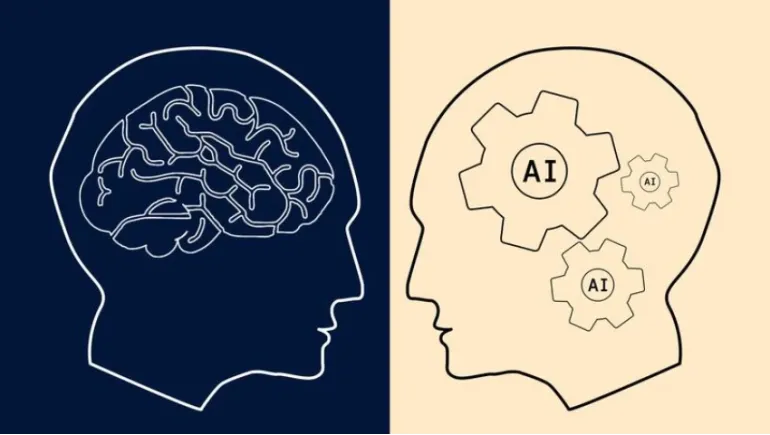
Artificial Intelligence (AI) is transforming industries, from healthcare to finance, education to entertainment. But as AI systems grow more sophisticated, a fundamental question continues to spark curiosity and debate: how does artificial intelligence compare to the human brain?
While both AI and the human brain process information, learn from experience, and make decisions, their mechanisms and limitations are profoundly different. This article dives deep into how artificial intelligence stacks up against the human brain in terms of structure, processing, learning, creativity, emotion, and more.
The human brain contains approximately 86 billion neurons, with trillions of synaptic connections. These neurons operate in parallel, allowing for real-time perception, reflexes, emotional processing, and abstract thought.
In contrast, AI runs on hardware—processors, GPUs, and memory chips. While traditional computers process information linearly and at high speeds, they lack the massively parallel structure of the brain. However, with neural networks and parallel computing, AI has begun to mimic some aspects of human neural activity. Still, the brain’s efficiency remains unmatched—it's capable of operating on about 20 watts of power, while training large AI models can consume thousands of watts.
Human learning is flexible, intuitive, and often unsupervised. From infancy, humans learn language, social cues, and problem-solving through interaction and observation. Our brains can generalize from limited data and apply past experiences to new situations.
AI, on the other hand, relies heavily on data. Machine learning algorithms require vast datasets and multiple iterations to learn patterns. Although models like GPT-4 and AlphaGo have shown impressive learning, they still struggle with generalizing beyond their training data. Transfer learning and few-shot learning have improved adaptability, but human cognition remains superior in flexible learning.
Creativity is a complex trait involving imagination, emotion, and the ability to connect seemingly unrelated concepts. The human brain excels here—producing music, art, literature, and original ideas across disciplines.
AI can generate content, mimic styles, and even create music or art, but it does so by identifying patterns in existing works. It lacks intrinsic creativity and emotional context. AI-generated art may be impressive, but it’s ultimately derivative. It doesn’t "feel" inspiration or emotion; it simulates based on training data.
Emotionally, humans process experiences through a rich inner world of feelings, memories, and social instincts. AI does not experience emotion. While it can recognize emotional cues or simulate empathetic responses (e.g., in customer service bots), there is no genuine emotional understanding or consciousness.
Humans make decisions based on a mix of logic, intuition, experience, and ethics. We factor in morality, long-term consequences, and empathy—traits rooted in culture, biology, and psychology.
AI makes decisions based on algorithms, probabilities, and optimization functions. It can analyze massive data sets and identify optimal outcomes faster than humans, especially in structured environments like games or logistics. However, AI lacks a moral compass. Ethical decision-making in AI depends entirely on human programmers and the values encoded into its systems.
This raises concerns about AI in critical areas like law enforcement, healthcare, and autonomous vehicles, where decisions have human consequences. The lack of conscience in AI means it must always operate under human oversight.
In terms of raw computation, AI surpasses the human brain. It can process information at lightning speed, analyze massive datasets, and perform complex calculations instantly.
However, speed is not everything. The human brain integrates sensory input, emotions, memories, and social context seamlessly, something AI still struggles to emulate. Humans are better at abstract thinking, making sense of ambiguity, and acting with limited information. AI is faster, but not wiser.
One of the most profound differences is consciousness. Humans are self-aware; we have thoughts about our thoughts, reflect on our actions, and question our existence.
AI, no matter how advanced, does not possess consciousness. It can simulate conversation, predict behavior, and even mimic self-reflection, but there is no inner experience. Consciousness remains uniquely human (or at least biological), and science has yet to create an artificial equivalent.
AI can store and retrieve data with perfect accuracy. Its memory doesn’t degrade or forget—unless intentionally programmed to do so.
Human memory is fallible. We forget, misremember, or reinterpret past experiences. However, this flexibility is also a strength. Our memories are tied to emotion and meaning, which influences learning, creativity, and empathy. AI stores data; humans interpret and live it.
The human brain has its limits: it tires, ages, and is vulnerable to disease. In contrast, AI can operate 24/7, scale globally, and work across disciplines without fatigue.
Yet AI has limits, too. It cannot understand nuance, lacks emotional depth, and depends on human input for context, goals, and values. It’s also vulnerable to bias, errors, and ethical misuse depending on how it’s trained and applied.
Comparing artificial intelligence to the human brain is like comparing a calculator to a poet. Each excels in different areas. AI is a powerful tool—fast, efficient, and capable of automating routine tasks. But the human brain remains the most adaptable, creative, and emotionally rich system we know.
Rather than viewing AI as a competitor, it's more productive to see it as a complement. When used responsibly, AI can enhance human potential—supporting decisions, solving problems, and even inspiring new ideas. But it cannot replace human insight, emotion, or consciousness.
As AI continues to evolve, understanding its limitations and its relationship to human intelligence is crucial. The future isn't man versus machine, but man with machine—working together to build smarter, more humane technology.












Comments
There are no comments for this Article.